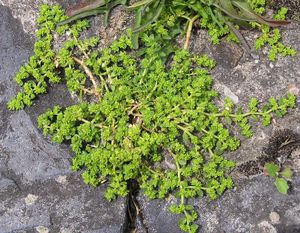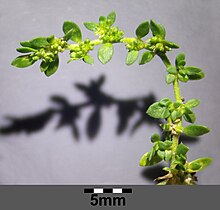Bald broken herb
| Bald broken herb | ||||||||||||
|---|---|---|---|---|---|---|---|---|---|---|---|---|

Bald hernia ( Herniaria glabra ) |
||||||||||||
| Systematics | ||||||||||||
|
||||||||||||
| Scientific name | ||||||||||||
| Glabra hernia | ||||||||||||
| L. |
The Kahle Rupturewort ( Herniaria glabra ) is a plant from the family of the Pink family (Caryophyllaceae). This type is also called Christians welding , Dürr herb , Smooth thousand herb , Harnkraut , maiden grass , cuckoo soap , kidney herb , thousand grain or passion flowers called.
description
The bald curly herb is a herbaceous plant that is annual, biennial or perennial . Sometimes it lignifies weakly at the base. The whole plant is fresh green to yellowish green. The bald curly herb shows all typical characteristics of the genus curly herbs . The stem is typically 5 to 15 cm long, but can be up to 30 cm long. The leaves and the stem are completely bare or at most very briefly ciliate. The triangular stipules are about 0.5 to 1.5 mm long.
The sessile, hermaphrodite flowers are five-fold. The sepals are green, elliptical and bluntly pointed. The white petals are much smaller than the sepals and often they are missing entirely. There are five fertile stamens and five petal-like staminodes .
The number of chromosomes is 2n = 18.
ecology
The bald curly herb is a perennial hemicryptophyte or a creeping therophyte . Since the sturdy plant lies close to the ground, it is often overlooked. When dry, it smells of woodruff .
The pre-female flowers are only about 1 mm in size. The pollination is done by tiny Fly ; is also self-pollination possible. Flowering time is from June to October.
The units of expansion are the nuts enclosed by the permanent flower cover and therefore specifically light, rough, solitary. They spread as balloon fliers, as rainworms and as water-bound people (e.g. on shoes). The seeds are glossy black, lenticular, and 0.5 mm long. Fruit ripening is from July to October.
Occurrence

The bald break herb occurs in the temperate latitudes of Europe and western Asia . In North America it has been introduced in places.
It originally grows on dry sand and in heather. Today it is mostly found in sandy ruderal places such as B. in the pavement cracks of rarely used traffic islands or between the stones of dams. In Central Europe it is a character species of the Rumici-Spergularietum from the association Polygonion avicularis, but also occurs in societies of the Sedo-Scleranthetea class.
pharmacology
The herb contains up to 10% saponins , flavonoids and coumarins as active ingredients . The dried above-ground parts are used. In laboratory rats, a decrease in excessive blood pressure and an increase in the filtration rate of their kidneys have been observed; Broken herb tea is used in folk medicine as a diuretic for flushing therapy for urinary stones, kidney gravel and cramps. A weak spasmolytic effect of the drug is accepted, but the effectiveness in the folk medical application areas has not yet been adequately proven. Together with the lingonberry, the broken herb showed the strongest antimicrobial effect against uropathogenic Escherichia coli bacteria within a series of tested substances and is therefore effective against bladder and ureter diseases.
Individual evidence
- ^ A b Manfred A. Fischer, Karl Oswald, Wolfgang Adler: Excursion flora for Austria, Liechtenstein and South Tyrol . 3rd, improved edition. State of Upper Austria, Biology Center of the Upper Austrian State Museums, Linz 2008, ISBN 978-3-85474-187-9 .
- ^ John W. Thieret, Ronald L. Hartman, Richard K. Rabeler: Herniaria. In: Flora of North America Editorial Committee (Ed.): Flora of North America North of Mexico . Volume 5: Magnoliophyta: Caryophyllidae, part 2 . Oxford University Press, New York / Oxford a. a. 2005, ISBN 0-19-522211-3 (English, online ). (engl.).
- ^ Lu Dequan, Michael G. Gilbert: Herniaria. In: Wu Zhengyi, Peter H. Raven, Deyuan Hong (Eds.): Flora of China . Volume 6: Caryophyllaceae through Lardizabalaceae . Science Press / Missouri Botanical Garden Press, Beijing / St. Louis 2001, ISBN 1-930723-05-9 , pp. 3 (English, online ). (engl.).
- ↑ a b Erich Oberdorfer : Plant-sociological excursion flora for Germany and neighboring areas . 8th edition. Verlag Eugen Ulmer, Stuttgart 2001, ISBN 3-8001-3131-5 . Page 390.
- ↑ a b c Ruprecht Düll , Herfried Kutzelnigg : Pocket dictionary of plants in Germany and neighboring countries. The most common Central European species in portrait . 7th, corrected and enlarged edition. Quelle & Meyer, Wiebelsheim 2011, ISBN 978-3-494-01424-1 , p. 387 .
- ↑ H. Rhiouani, A. Settaf, B. Lyoussi, Y. Cherrah, MA Lacaille-Dubois, M. Hassar: Effects of saponins from Herniaria glabra on blood pressure and renal function in spontaneously hypertensive rats. In: Therapy. Vol. 54, No. 6, 1999, pp. 735-739. PMID 10709449 .
- ↑ Beatrice Gehrmann, Wolf-Gerald Koch, Claus O. Tschirch, Helmut Brinkmann: Medicinal Herbs: A Compendium. Haworth Herbal Press, New York 2005, ISBN 0-7890-2530-2 , p. 103.
- ↑ Irene Barnickel, Friedrich Häfele, Wolfgang Kreis: Erlangen Botanical Garden. Medicinal plants. Information sheet . 2nd Edition. Erlangen Botanical Garden of the Friedrich-Alexander University Erlangen-Nuremberg, Erlangen, p. 50 .
- ↑ Dorota Wojnicz, Alicja Z. Kucharska, Anna Sokół-Łętowska, Marta Kicia, Dorota Tichaczek-Goska: Medicinal plants extracts affect virulence factors expression and biofilm formation by the uropathogenic Escherichia coli. In: Urological Research. Volume 40, No. 6, 2012, pp. 683-697, DOI: 10.1007 / s00240-012-0499-6 , PMID 22915095 . PMC 3495101 (free full text).
Web links
- Bald broken herb. In: FloraWeb.de.
- Distribution map for Germany. In: Floraweb .
- Herniaria glabra L. In: Info Flora , the national data and information center for Swiss flora .
- Distribution in the northern hemisphere from: Eric Hultén, Magnus Fries: Atlas of North European vascular plants. 1986, ISBN 3-87429-263-0 at Den virtuella floran (swed.)
- Thomas Meyer: Data sheet with identification key and photos at Flora-de: Flora von Deutschland (old name of the website: Flowers in Swabia )
- Carl von Linné: Species Plantarum. Volume 1, Lars Salvius, Stockholm 1753, p. 218 (first description).


